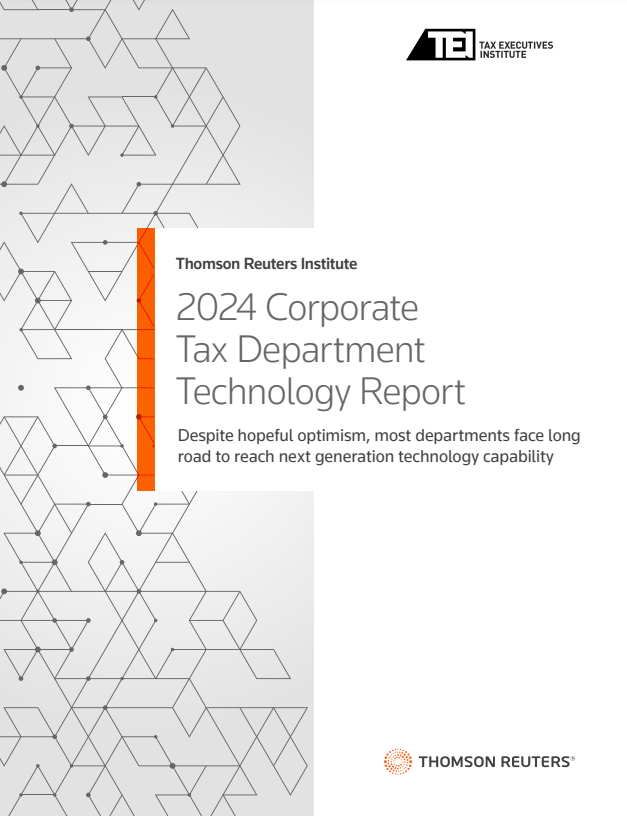Forward-thinking business leaders drive innovation and growth by leveraging tax technology to fuel their company’s success. By implementing advanced tax data management software, your tax department can streamline operations, reduce costs, and improve accuracy. This enables your tax professionals to focus on high-value activities that drive business growth and strategic decision-making. With real-time information and data-driven intelligence, your tax department can become a trusted advisor to the business. This will help them make smart financial decisions and lead to long-term success.
Build the tax department of the future
In today’s rapidly evolving business and tax landscape, prioritizing strategies that drive efficiency, mitigate risk, and unlock strategic value is more important than ever. The Thomson Reuters Institute 2024 Corporate Tax Technology Report shows that the adoption of tax data systems remains varied among organizations.
The report says that 33% of the people who answered said they already have a tax data system. This shows that they are taking a proactive approach to managing tax-related information. Meanwhile, 14% of people plan to buy a system like this in the next year. They know that these technologies could be beneficial for them. Interestingly, a significant 53% of respondents stated that they do not intend to purchase a tax data platform in the coming year.
As you think about what your tax department needs in the future, consider making a good reason to invest in tax technology. It can help create new ideas, make things easier, and make better decisions. By doing this, you can make your tax department a strategic partner to the business. It will be able to handle the complex tax laws of today and help the business succeed in the future.
Decide whether to buy or build your tax data software
Your decision-making team should include global users of the tax data software as well as any business stakeholders who would like to harness your tax data. For example, finance, global trade, and compliance functions benefit from easier access to accurate tax data and better reporting capabilities. Similarly, senior business leaders profit from improved, real-time reporting and analytics.
Once your team is in place, it’s time to investigate buying vs. building. To make the business case for either investment, you and the other decision-makers will need to evaluate cost, capabilities, users, scope of deployment, security, maintenance, and upgrade obligations, and time to value, among other variables.
Building tax technology by extending your ERP system with customized processes is a common approach. Unfortunately, it can require significant up-front investment and result in entrenched business silos and long delays. It can also create a lack of agility over time, or in extreme cases, cause systemic process failures. On the other hand, buying a proven tax data software solution from an experienced technology partner can circumvent these problems while also saving money. You can integrate tax data software with an ERP system, and you gain control over your tax planning and obligations with up-to-date and accurate data.
Build your case for transforming tax management with advanced data software
In today’s rapidly evolving tax landscape, building a compelling case for investing in advanced tax data software is essential for forward-thinking businesses. As global tax regulations grow increasingly complex, with initiatives like Pillar 2.0 and global minimum tax requirements, companies must revolutionize their approach to managing and analyzing vast amounts of tax data.
Advanced tax data software offers a transformative solution, empowering your corporate tax department with tools to automate time-consuming tasks, ensure compliance, and dramatically improve accuracy. By leveraging cutting-edge technologies such as data warehouses, analytics tools, and AI-driven insights, your team can shift focus to high-value, strategic work that drives business growth.
With governments worldwide, including the UK’s ViDA initiative, embracing data-driven tax administration, investing in advanced software is crucial for staying ahead. This technology not only minimizes risks but also attracts top talent by offering a modern, technologically advanced work environment. While there’s an initial investment, the long-term benefits — including substantial cost savings, enhanced decision-making capabilities, and a competitive edge in tax management — make a strong case for transformation. By highlighting these advantages, you can construct a powerful argument for adopting advanced tax data software, positioning your business at the forefront of tax management innovation and turning data challenges into strategic opportunities.
Find the best tax technology solution for your case
Your team has been given the green light to buy tax technology, but which solution should you choose? There are many options on the market, from holistic platforms to specialist solutions. Here are some key considerations to help you get the right solution for your organization:
- Global coverage. If you run a global business, you’ll want to implement a global platform. You’ll want coverage for all tax types in all the jurisdictions you operate in, to streamline compliance, identify and capitalize on incentives, and avoid penalties.
- Scalability and flexibility. Your tax platform should be cloud-based and scale with business growth. It should be easy to set up, so you can connect it easily with one or more ERP systems and other solutions.
- Ease of collaboration. You work with multiple departments and report to senior stakeholders. You’ll want access to collaboration, research, and workflow on a single hosted platform, to increase visibility and reduce risk. Empower your tax professionals with tools that use artificial intelligence for fast information retrieval.
- Department alignment. Tax regulations are constantly changing and challenging your responsiveness. Use a digital platform to align tax operations across departments, providing users with access to accurate, real-time information. Eliminate repetitive manual processes so that your tax professionals can focus on higher-level tasks.
- Digital governance. Keep pace with the latest regulatory changes to ensure that your tax is accurately forecast and spend is right the first time. Provide tax data and reporting that supports internal auditing and meets the rigors of tax authority scrutiny.
Develop your tax data management strategy
When developing your tax data management strategy, identify your desired future state, key stakeholders, data sources, and processes for gathering, standardizing, and cleaning your data. For example, it’s common for tax departments to source data from multiple systems and functions that are not integrated. This disparate data is often out of date and can increase delays and introduce errors in key processes.
A critical next step is to build a data lake to aggregate and transform the data. Then, create a single, centralized repository to make your tax data more accessible and usable to business functions. To eliminate low-level data requests and increase responsiveness, you can provide self-service to your tax department and key business functions.
By creating a single place to store tax data, you can make your data better over time. This will make it easier to use and help you analyze it. You’ll be able to develop and syndicate reports that provide the business with up-to-date tax metrics and answers to questions before they’re even asked.
Future-proof your tax department with tax data software
The ongoing changes and challenges in the corporate tax landscape have shown us not only how swiftly change can occur, but also how new business and customer demands become entrenched, speeding up business processes to serve these demands. The current environment is providing a real-life business case for adopting tax technology now – and manual processes are increasingly out of step with digital business and regulatory change.
While some tax departments are moving ahead with tax data software, many tax departments are still taking a “watch and wait” attitude. But this attitude has consequences: departments that don’t invest in technology risk remaining operational rather than moving to a strategic technology posture, limiting their ability to align with broader business objectives. Those tax departments that do adopt tax data software this year have an opportunity to move ahead of their peers. They’ll differentiate their services and deliver exceptional results that create significant business momentum. Will you be one of them?
For more information to help you transform your tax department, check out our resources:
 |
|







